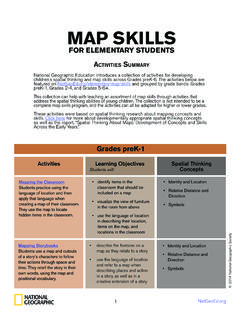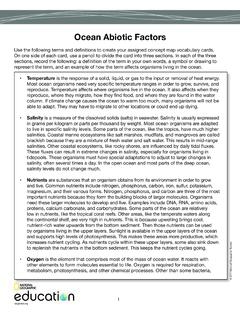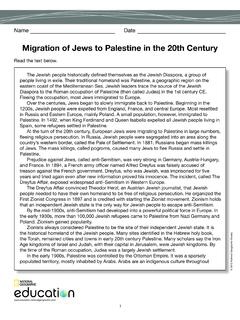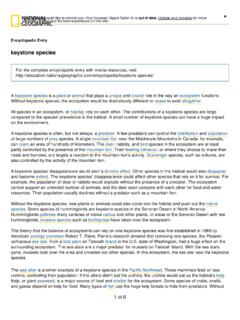Transcription of MAP SKILLS - National Geographic Society
1 1 2014 National Geographic SKILLS FOR ELEMENTARY STUDENTSA ctivities summAryNational Geographic Education introduces a collection of activities for developing children s spatial thinking and map SKILLS across Grades preK-6. The activities below are featured on and grouped by grade bands: Grades preK-1, Grades 2-4, and Grades 5-6+. This collection can help with teaching an assortment of map SKILLS through activities that address the spatial thinking abilities of young children. The collection is not intended to be a complete map SKILLS program, and the activities can all be adapted for higher or lower activities were based on spatial thinking research about mapping concepts and SKILLS . Click here for more about developmentally appropriate spatial thinking concepts as well as the report, Spatial Thinking About Maps: Development of Concepts and SKILLS Across the Early Years. Mapping StorybooksStudents use a map and cutouts of a story s characters to follow their actions through space and time.
2 They retell the story in their own words, using the map and positional vocabulary. describe the features on a map as they relate to a story use the language of location and refer to a map when describing places and action in a story, as well as in a creative extension of a story Identity and Location Relative Distance and Direction SymbolsMapping the ClassroomStudents practice using the language of location and then apply that language when creating a map of their classroom. They use the map to locate hidden items in the classroom. identify items in the classroom that should be included on a map visualize the view of furniture in the room from above use the language of location in describing their location, items on the map, and locations in the classroom Identity and Location Relative Distance and Direction SymbolsGrades preK-1 ActivitiesLearning Objectives Students will:Spatial Thinking Concepts2 2014 National Geographic in the ParkStudents explore a map of a park and use map symbols, a map key, and cardinal directions to analyze , Water, and Animals on a MapStudents determine the colors for land and water on a map.
3 They read a map and create a chart of animals that live in water and on Maps and Models of Earth Students compare miniature models to real things. Then they explore maps and globes as miniature versions of places and the Sun, Earth, and Cardinal Directions Students record the position of the sun in the morning and afternoon and make connections to the directions east and west. They practice moving north, south, east, and west and use cardinal directions to read a map. name the meanings of symbols on a map and map key describe the location of items on a map in relation to other items use cardinal direction to describe location of things on a map draw a map of familiar places using symbols and cardinal directions use a map to identify land and water use a map to identify and sort animals that live on land and animals that live in water describe the difference between a model of something and the real thing describe places they see on different maps explain the difference between a photograph of Earth and a globe describe the pattern of the location of the sun each morning and afternoon and connect this to the directions east and west name the cardinal directions and point toward north, south, east, and west using signs in their classroom use north, south, east.
4 And west when describing locations of items on a map Identity and Location Relative Distance and Direction Symbols Identity and Location Symbols Identity and Location Magnitude Symbols Relative Distance and Direction Symbols3 2014 National Geographic a Grid With a Zoo MapStudents use a map grid to describe and find locations on a zoo map and a city map. They use a grid to create a message. describe the purpose of a map grid use a grid to locate places on a map Reference Frames Identity and LocationMany Ways to Name a PlaceStudents analyze maps of places from neighborhood to world and then create maps for the locations of their own homes at multiple scales. identify a location in a neighborhood, city, state, country, continent, and the world describe the map features at different scales identify their own location in the world Identity and Location HierarchiesGrades 2-4 Measuring Distances on a MapStudents use a map scale to measure distance between cities and other places on a map of your state.
5 They create and exchange quizzes and use an interactive map to check their answers. explain the purpose of a map scale identify the two kinds of measurement used on a map scale use a map scale to measure distances between places Distance and Direction HierarchiesCardinal Directions and Maps Students listen to a poem that uses cardinal directions. They use a compass rose to help describe locations of places on a world map. use a compass rose to describe position and movement on a map locate and name Earth s continents and oceans Identity and Location Relative Distance and DirectionActivitiesLearning Objectives Students will:Spatial Thinking Concepts4 2014 National Geographic a Community MapStudents make observations and gather information over several days or sessions. Then they summarize reasons why public services are located where they Your StateStudents research political, physical, and cultural features of their own state or district and work collaboratively to create a state tourism a Weather MapStudents draw pictures that symbolize different types of weather and then use information about today s weather to make their own state weather Latitude/ longitude PuzzleStudents use latitude, longitude , and research on characteristics of different states and regions to solve a puzzle.
6 Examine a map of the neighborhood around their school and analyze why that site was selected for the school analyze the spatial arrangements of the locations of their homes, school, and community services on a community map determine reasons for site selections for neighborhood public services Identity and Location Reference Frames research political, physical, and cultural features of their state that are important for tourism create a map legend with symbols for each feature mark the features on an outline map using a grid Identity and Location Symbols Reference Frames explain the ways in which a weather map shows weather and temperature illustrate symbols for specific types of weather create a local weather map using symbols and current weather information Identity and Location Symbols identify locations on a map using latitude and longitude compare and contrast the characteristics of places to determine the likelihood of an event consider how the characteristics of a place influence our activities Identity and Location Reference Frames5 2014 National Geographic LandformsStudents analyze landform maps of a state and the United States.
7 They research and map states landforms and then create a Erie CanalStudents interact with maps to analyze the geography of the New York region and identify how elevation influenced the development of trade, trade routes, and the growth of cities in that region. Mapping WatershedsStudents trace the Mississippi River and its major tributaries on a map of the United States. They use an interactive map or atlases to locate other major rivers and identify the major watersheds. identify landforms locate landforms on a map create a display featuring landforms in the United States Identity and Location Hierarchies describe the location of New York as an important location for transportation and trade in the 1800s label locations and features of the New York region on a map identify mountains and high elevation regions on a map identify low elevation regions on a map predict transportation routes based on elevation using a map identify cities on a map and differentiate population size based on map symbology explain how water transportation routes can offer economic benefits in trade Identity and Location Symbols Hierarchies identify and label the Mississippi River and its source, mouth, major tributaries.
8 And watershed on a map identify other major rivers and watersheds analyze the relationship of watersheds to major mountain ranges Identity and Location Symbols Reference FramesReading a Resource MapStudents read a natural resource map and use a chart to determine the origins of goods that people use. use a resource map to locate natural resources identify products made from various natural resources Identity and Location Symbols6 2014 National Geographic , longitude , and TemperatureStudents look at lines of latitude and longitude on a world map, predict temperature patterns, and then compare their predictions to actual temperature data on an interactive map. They discuss how temperatures vary with latitude and the relationship between latitude and general climate LandformsStudents analyze landform maps of a state and the United States. They research and map states landforms and then create a Mapping and PerceptionStudents rate their desire to live in different states.
9 They use mental maps to explore student perceptions of different areas of the 5-6+ActivitiesLearning Objectives Students will:Spatial Thinking Concepts make predictions about temperature patterns around the world compare their predictions with actual temperature data on an interactive world map explain how average temperature varies with latitude Identity, Location, Distance, and Direction Symbols Overlay and Complex Spatial Concepts identify landforms locate landforms on a map create a display featuring landforms in the United States Identity, Location, Distance, and Direction use mental mapping to define their perceptions of states analyze their own Geographic perceptions and the perceptions of others identify regional differences in perceptions Symbols Overlay and Complex Spatial Concepts7 2014 National Geographic Settlement SitesStudents work in groups to make decisions about where to build settlements in hypothetical places. They consider site features and locational factors in the decision-making.
10 Satellite Imagery and Change Over TimeStudents view satellite images of places past and present and analyze the changes over a London EpidemicStudents analyze patterns of cholera in an area of London, similar to how Dr. John Snow, father of epidemiology, did in Historical MapsStudents compare maps of Boston in 1775 and today and identify how humans have altered the landscape. They describe how changes in population affect the physical characteristics of a place. describe factors that influence the location and settlement of sites describe factors that influence the growth of urban sites describe how factors that influence site selection and urban growth change in relative importance over time make group decisions to evaluate and select settlement sites Identity, Location, Distance, and Direction Symbols Overlay and Complex Spatial Concepts Identity, Location, Distance, and Direction Overlay and Complex Spatial Concepts analyze maps to solve problems follow steps taken in mapping an epidemic and evaluate how conclusions were drawn analyze features shown on satellite images analyze changes over time using satellite imagery Identity, Location, Distance.








